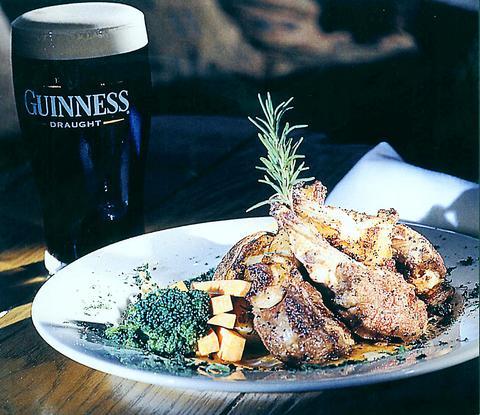The manager of The Shannon Irish Pub rang the cowbell and the free liquor flowed.
Of course, it's not every day The Shannon holds a two-hour, all-you-can-drink, open bar. But since this pub, located in the Songshan district of Taipei, had just celebrated its second anniversary last weekend, the general manager from Australia, Darren Hassan thought it was only fitting.

PHOTO COURTESY OF YOGI HOUSE INTERNATIONAL
"Cheers mate!"he said, smoking a cigar and sipping a glass of red wine, while greeting customers earlier in the week.
The Shannon is more than just a place to drink, though. Besides beer taps with Guinness, Kilkenny and Carlsberg, as well as a fully-stacked liquor bar, customers also have dozens of dishes to choose from, including bar appetizers like fried calamari rings and chicken fingers, or more traditional Irish fare such as shepherd's pie and Irish stew.
The shepherd's pie, which substitutes lamb with beef, was a decent-sized portion enough for one person. Baked and served in a casserole dish, the filling was made with meat, tomatoes, peas and carrots, cooked into a thick stew. The obligatory mashed potatoes were then smeared on and browned. All in all a safe bet, costing NT$355.
The Irish stew, replete with tender chunks of lamb and vegetables, was more soupy than thick, as was pointed out in the menu. Despite its luke-warm temperature, the seasoning wasn't at all overpowering, allowing the natural flavors of the potatoes and carrots to mix nicely with the lamb. The stew was garnished with barley and served with two slices of rye bread. The cost: NT $375.
The Shannon's menu also features a variety of desserts like Bailey's Irish mousse, employing the velvety Irish cream liqueur as one of its ingredients, as well as warm chocolate walnut brownies, topped with a chocolate sauce made from Bushmills Irish Whiskey. And to follow that, a drink only an Irishman would think up: Irish coffee.
Hassan said The Shannon seeks to please expats with the food and spirits, while at the same exposing Taiwanese to a fresh, new cultural experience.
"It is a familiar setting that seems to work," he said of the pub's decor, which is heavy on the shamrocks and wood, and light on the pretense. "It definitely has a casual feel to it."
In that sense, The Shannon succeeds, evidenced by the diverse crowd it attracts. During the two-hour open bar, customers seemed especially happy after hearing news that a typhoon had caused the Taipei city government to cancel work the next day. "Might as well keep drinking," screamed one patron over the din of the cover band.

On April 26, The Lancet published a letter from two doctors at Taichung-based China Medical University Hospital (CMUH) warning that “Taiwan’s Health Care System is on the Brink of Collapse.” The authors said that “Years of policy inaction and mismanagement of resources have led to the National Health Insurance system operating under unsustainable conditions.” The pushback was immediate. Errors in the paper were quickly identified and publicized, to discredit the authors (the hospital apologized). CNA reported that CMUH said the letter described Taiwan in 2021 as having 62 nurses per 10,000 people, when the correct number was 78 nurses per 10,000

As we live longer, our risk of cognitive impairment is increasing. How can we delay the onset of symptoms? Do we have to give up every indulgence or can small changes make a difference? We asked neurologists for tips on how to keep our brains healthy for life. TAKE CARE OF YOUR HEALTH “All of the sensible things that apply to bodily health apply to brain health,” says Suzanne O’Sullivan, a consultant in neurology at the National Hospital for Neurology and Neurosurgery in London, and the author of The Age of Diagnosis. “When you’re 20, you can get away with absolute

May 5 to May 11 What started out as friction between Taiwanese students at Taichung First High School and a Japanese head cook escalated dramatically over the first two weeks of May 1927. It began on April 30 when the cook’s wife knew that lotus starch used in that night’s dinner had rat feces in it, but failed to inform staff until the meal was already prepared. The students believed that her silence was intentional, and filed a complaint. The school’s Japanese administrators sided with the cook’s family, dismissing the students as troublemakers and clamping down on their freedoms — with

As Donald Trump’s executive order in March led to the shuttering of Voice of America (VOA) — the global broadcaster whose roots date back to the fight against Nazi propaganda — he quickly attracted support from figures not used to aligning themselves with any US administration. Trump had ordered the US Agency for Global Media, the federal agency that funds VOA and other groups promoting independent journalism overseas, to be “eliminated to the maximum extent consistent with applicable law.” The decision suddenly halted programming in 49 languages to more than 425 million people. In Moscow, Margarita Simonyan, the hardline editor-in-chief of the